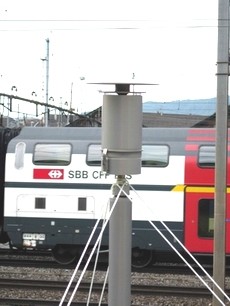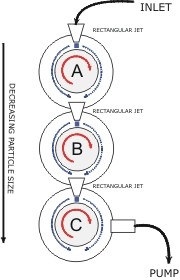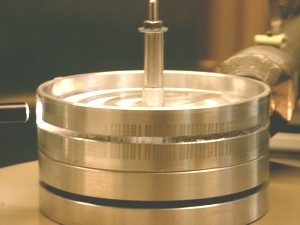Railway Emissions
Scope of project
Ambient aerosol samples were collected near a Swiss major railway line with help of a rotating drum impactor (RDI). This impactor type allowed for size-segregated collection of ambient aerosol (three size ranges) on a thin Mylar substrate strip. The Mylar strips were analyzed by synchrotron X-ray fluorescence spectroscopy (SR-XRF) at the synchrotron source at HASYLAB (DESY) in Hamburg, Germany. In urban ambient air an aerosol accumulation time of one hour on the Mylar tape provides enough material to measure SR XRF spectra of good quality. Elements of special interest were S, K, Cl, Ca, Ti, Cr, Mn, Fe, Ni, Cu, Zn, Br as well as Pb, Pt, Pd and Rh, since they serve as fingerprints for different sources.
Aerosol Sampling with Rotating Drum Impactors (RDI)
The project aimed at high time resolution elemental analysis of ambient air samples. A three-stage rotating drum impactor (RDI) collected ambient aerosol in three size ranges (aerodynamic particle diameter D(ae) = 0.1-1 µm, 1-2.5 µm and 2.5-10 µm) with a time resolution of 1 hour by particle impaction and deposition on a thin Mylar substrate tape (1.8 µm), which was greased (APIEZON L) to prevent particle bouncing.
Synchrotron Radiation-induced X-ray Fluorescence Spectrometry
RDI samples were analysed at the HASYLAB L-beamline in August 2003 and March 2004. For the measurements, a monoenergetic (15 keV) X-ray microbeam (1200x500 µm2) was available, with a Ni/C monochromator for an energy interval of 10-100 keV. An HPGe or a SiLi detector were used for fluorescence measurement. The deposited aerosol was analysed point by point on the RDI Mylar tapes. Absolute calibration of the measured XRF spectra was performed using stock solutions with known element concentrations.
Key findings
- Chromium (Cr), manganese (Mn), iron (Fe) and copper (Cu) are the elements most relevant for railway abrasion.
- The comparison to train type and frequency data showed that 75% and 60% of the iron and manganese mass concentrations related to cargo and passenger trains, respectively, were found in the coarse mode.
- The railway related iron mass concentration normalized by the train frequency ranges between 10 and 100 ng m-3 h iron in 10 m distance to the tracks, depending on train type.
Publications
Journal Articles
Iron, manganese and copper emitted by cargo and passenger trains in Zürich (Switzerland): Size-segregated mass concentrations in ambient air.Bukowiecki, N., R. Gehrig, M. Hill, P. Lienemann, C. N. Zwicky, B. Buchmann, E. Weingartner, and U. Baltensperger, 2007
Atmos. Environ., 41, 878-889.
DOI: 10.1016/j.atmosenv.2006.07.045
Trace metals in ambient air: Hourly size-segregated mass concentrations determined by synchrotron-XRF.
Bukowiecki, N., M. Hill, R. Gehrig, C. N. Zwicky, P. Lienemann, F. Hegedüs, G. Falkenberg, E. Weingartner, and U. Baltensperger, 2005
Environmental Science and Technology, 39, 5754-5762.
DOI: 10.1021/es048089m
Contribution of railway traffic to local PM10 concentrations in Switzerland.
Gehrig, R., M. Hill, P. Lienemann, C. N. Zwicky, N. Bukowiecki, E. Weingartner, U. Baltensperger, and B. Buchmann, 2007
Atmos. Environ., 41, 923-933.
DOI: 10.1016/j.atmosenv.2006.09.021


